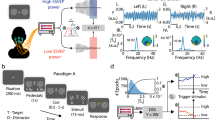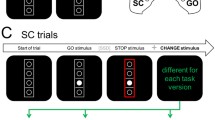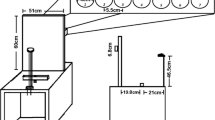Abstract
It has been shown that visually guided and memory-guided actions are under the control of dissociable neural systems. This experiment measured event-related potentials (ERPs) in a cross-modal dual-task paradigm to investigate the attentional requirements of these two types of actions. In a primary joystick-controlled continuous reciprocal aiming task, participants moved a cursor back and forth between two targets of variable size in visually guided (VIS) and memory-guided (MEM) conditions. In a secondary dichotic listening task, ERPs were collected while infrequent high and frequent low pitch tones were delivered to both ears. Participants responded to the infrequent tones delivered to only one attended ear. Aiming and listening were performed separately and together as a dual task. We were interested in two ERP components: the P300 component, which reflects voluntary attention, and the mismatch negativity (MMN), which reflects automatic attention. The results showed that the P300 component elicited by the auditory task was decreased in amplitude by the dual-task conditions compared with the auditory task alone. Moreover, P300 latency was increased by the MEM aiming condition, but not the VIS aiming condition. On the other hand, the MMN component elicited by the auditory task was only attenuated by the VIS aiming condition, not by the MEM aiming condition. Together, these results suggest that memory-guided aiming requires more voluntary attention and less automatic attention than visually guided aiming.



Similar content being viewed by others
References
Alho K, Woods DL, Algazi A, Näätänen R (1992) Intermodal selective attention. II. Effects of attentional load on processing of auditory and visual stimuli in central space. Electroencephalogr Clin Neurophysiol 82:356–368
Alonso TO, Fernandez A, Benbunnan B, Maestu F, de Miguel T (1996) Contributions of temporal-parietal junction lesions to the human auditory P300. Psicothema 8:291–296
Astafiev SV, Shulman GL, Stanley CM, Snyder AZ, Van Essen DC, Corbetta M (2003) Functional organization of human intraparietal and frontal cortex for attending, looking, and pointing. J Neurosci: Off J Soc Neurosci 23:4689–4699
Binkofski F, Dohle C, Posse S, Stephan KM, Hefter H, Seitz RJ, Freund HJ (1998) Human anterior intraparietal area subserves prehension: a combined lesion and functional MRI activation study. Neurology 50:1253–1259
Bledowski C, Prvulovic D, Hoechstetter K, Scherg M, Wibral M, Goebel R, Linden DE (2004) Localizing P300 generators in visual target and distractor processing: a combined event-related potential and functional magnetic resonance imaging study. J Neurosci: Off J Soc Neurosci 24:9353–9360. doi:10.1523/JNEUROSCI.1897-04.2004
Cabeza R, Dolcos F, Prince SE, Rice HJ, Weissman DH, Nyberg L (2003) Attention-related activity during episodic memory retrieval: a cross-function fMRI study. Neuropsychologia 41:390–399
Coles MGH, Smid HGOM, Scheffers MK JOL (1995) Mental chronometry and the study of human information processing. In: Rugg MD, Coles MGH (eds) Electrophysiology of mind. Event-related potentials and cognition. Oxford University Press, Oxford, pp 86–131
Culham JC, Danckert SL, DeSouza JF, Gati JS, Menon RS, Goodale MA (2003) Visually guided grasping produces fMRI activation in dorsal but not ventral stream brain areas. Exp Brain Res 153:180–189. doi:10.1007/s00221-003-1591-5
deFockert JW, Rees G, Frith CD, Lavie N (2001) The role of working memory in visual selective attention. Science 291:1803–1806. doi:10.1126/science.1056496
Donchin E, Karis D, Bashore TR, Coles MGH, Gratton G (1986a) Cognitive psychophysiology and human information processing. In: Coles MGH, Donchin E, Porges S (eds) Psychophysiology: systems, processes and applications. Guilford Press, New York, pp 244–266
Donchin E, Kramer AF, Wickens CD (1986b) Applications of brain event-related potentials to problems in engineering psychology. In: Coles MGH, Donchin E, Porges S (eds) Psychophysiology: systems, processes and applications. Guilford Press, New York, pp 702–778
Duncan J (1984) Selective attention and the organization of visual information. J Exp Psychol Gen 113:501–517
Fitts PM (1954) The information capacity of the human motor system in controlling the amplitude of movement. J Exp Psychol 47:381–391
Fitts PM, Peterson JR (1964) Information capacity of discrete motor responses. J Exp Psychol 67:103–112
Franz VH (2001) Action does not resist visual illusions. Trends Cogn Sci 5:457–459
Franz VH (2003) Manual size estimation: a neuropsychological measure of perception? Exp Brain Res 151:471–477. doi:10.1007/s00221-003-1477-6
Franz VH, Gegenfurtner KR, Bulthoff HH, Fahle M (2000) Grasping visual illusions: no evidence for a dissociation between perception and action. Psychol Sci: J APS 11:20–25
Franz VH, Bulthoff HH, Fahle M (2003) Grasp effects of the Ebbinghaus illusion: obstacle avoidance is not the explanation. Exp Brain Res 149:470–477. doi:10.1007/s00221-002-1364-6
Giard MH, Perrin F, Pernier J, Bouchet P (1990) Brain generators implicated in the processing of auditory stimulus deviance: a topographic event-related potential study. Psychophysiology 27:627–640
Giard MH, Lavikainen J, Reinikainen K, Perrin F, Bertrand O, Pernier J, Näätänen R (1995) Separate representation of stimulus frequency, intensity, and duration in auditory sensory memory—an event-related potential and dipole-model analysis. J Cogn Neurosci 7:133–143
Goodale MA (2008) Action without perception in human vision. Cogn Neuropsychol 25:891–919. doi:10.1080/02643290801961984
Goodale MA, Milner AD, Jakobson LS, Carey DP (1991) A neurological dissociation between perceiving objects and grasping them. Nature 349:154–156. doi:10.1038/349154a0
Goodale MA, Jakobson LS, Keillor JM (1994) Differences in the visual control of pantomimed and natural grasping movements. Neuropsychologia 32:1159–1178
Goodale MA, Westwood DA, Milner AD (2004) Two distinct modes of control for object-directed action. Prog Brain Res 144:131–144
Gopher D, Donchin E (1986) Workload: an examination of the concept. In: Boff KR, Kaufman L, Thomas JP (eds) Handbook of perception and human performance. vol II, Cognitive processes and performance. Wiley, New York, pp 41.41–41.49
Gratton G, Coles MG, Donchin E (1983) A new method for off-line removal of ocular artifact. Electroencephalogr Clin Neurophysiol 55:468–484
Heath M, Binsted G (2007) Visuomotor memory for target location in near and far reaching spaces. J Mot Behav 39:169–177. doi:10.3200/JMBR.39.3.169-178
Hommel B, Ridderinkhof KR, Theeuwes J (2002) Cognitive control of attention and action: issues and trends. Psychol Res 66:215–219. doi:10.1007/s00426-002-0096-3
Hu Y, Goodale MA (2000) Grasping after a delay shifts size-scaling from absolute to relative metrics. J Cogn Neurosci 12:856–868
Isreal JB, Chesney GL, Wickens CD, Donchin E (1980a) P300 and tracking difficulty: evidence for multiple resources in dual-task performance. Psychophysiology 17:259–273
Isreal JB, Wickens CD, Chesney GL, Donchin E (1980b) The event-related brain potential as an index of display-monitoring workload. Hum Fac 22:211–224
Jeannerod M (1994) The representing brain—neural correlates of motor intention and imagery. Behav Brain Sci 17:187–202
Jeannerod M, Arbib MA, Rizzolatti G, Sakata H (1995) Grasping objects: the cortical mechanisms of visuomotor transformation. Trends Neurosci 18:314–320
Johnson R Jr (1993) On the neural generators of the P300 component of the event-related potential. Psychophysiology 30:90–97
Kastner S, Ungerleider LG (2000) Mechanisms of visual attention in the human cortex. Annu Rev Neurosci 23:315–341. doi:10.1146/annurev.neuro.23.1.315
Keele S (1968) Motor Control. In: Kaufman L, Thomas J, Boff K (eds) Handbook of Perception and Performance. Wiley, New York
Keppel G (1991) Design and analysis: a researcher’s handbook. Prentice Hall, Englewood Cliffs
Kok A (1990) Internal and external control: a two-factor model of amplitude change of event-related potentials. Acta Psychol 74:203–236
Kok A (2001) On the utility of P3 amplitude as a measure of processing capacity. Psychophysiology 38:557–577
Kramer A, Spinks J (1991) Capacity views of human information processing. In: Jennings JR, Coles MGH (eds) Handbook of cognitive psychophysiology: central and autonomic nervous system approaches. Wiley, New York, pp 179–242
Kramer AF, Trejo LJ, Humphrey D (1995) Assessment of mental workload with task-irrelevant auditory probes. Biol Psychol 40:83–100
Kroliczak G, Cavina-Pratesi C, Goodman DA, Culham JC (2007) What does the brain do when you fake it? An fMRI study of pantomimed and real grasping. J Neurophysiol 97:2410–2422. doi:10.1152/jn.00778.2006
Kutas M, McCarthy G, Donchin E (1977) Augmenting mental chronometry: the P300 as a measure of stimulus evaluation time. Science 197:792–795
LaBar KS, Gitelman DR, Parrish TB, Mesulam M (1999) Neuroanatomic overlap of working memory and spatial attention networks: a functional MRI comparison within subjects. NeuroImage 10:695–704. doi:10.1006/nimg.1999.0503
LaBerge D (1995) Attentional processing: the brain’s art of mindfulness. Harvard University Press, Cambridge
Liu G, Healey CG, Enns JT (2003) Target detection and localization in visual search: a dual systems perspective. Percept Psychophys 65:678–694
Meehan S, Singhal A, Fowler B (2005) The late Nd reflects a memory trace containing amodal spatial information. Psychophysiology 42:531–539. doi:10.1111/j.1469-8986.2005.00309.x
Milner AD, Dijkerman HC, Pisella L, McIntosh RD, Tilikete C, Vighetto A, Rossetti Y (2001) Grasping the past. Delay can improve visuomotor performance. Curr Biol 11:1896–1901
Molholm S, Martinez A, Ritter W, Javitt DC, Foxe JJ (2005) The neural circuitry of pre-attentive auditory change-detection: an fMRI study of pitch and duration mismatch negativity generators. Cereb Cortex 15:545–551. doi:10.1093/cercor/bhh155
Mulert C, Pogarell O, Juckel G et al (2004) The neural basis of the P300 potential. Focus on the time-course of the underlying cortical generators. Eur Arch Psychiatry Clin Neurosci 254:190–198. doi:10.1007/s00406-004-0469-2
Näätänen R (1990) The role of attention in auditory information-processing as revealed by event-related potentials and other brain measures of cognitive function. Behav Brain Sci 13:201–232
Näätänen R (1992) Attention and brain function. Erlbaum, Hillsdale
Norman DA, Shallice T (1983) Attention to action—willed and automatic-control of behavior. Bull Psychon Soc 21:354
Otten LJ, Alain C, Picton TW (2000) Effects of visual attentional load on auditory processing. Neuroreport 11:875–880
Pashler H (1994) Dual-task interference in simple tasks—data and theory. Psychol Bull 116:220–244
Passingham RE (1996) Attention to action. Philos Trans R Soc B-Biol Sci 351:1473–1479. doi:10.1098/rstb.1996.0132
Polich J, Kok A (1995) Cognitive and biological determinants of P300: an integrative review. Biol Psychol 41:103–146
Ramirez J, Bomba M, Singhal A, Fowler B (2005) Influence of a visual spatial attention task on auditory early and late Nd and P300. Biol Psychol 68:121–134. doi:10.1016/j.biopsycho.2004.04.005
Schaal S, Sternad D, Osu R, Kawato M (2004) Rhythmic arm movement is not discrete. Nat Neurosci 7:1136–1143. doi:10.1038/nn1322
Serences JT, Yantis S (2006) Selective visual attention and perceptual coherence. Trends Cogn Sci 10:38–45. doi:10.1016/j.tics.2005.11.008
Singhal A, Fowler B (2004) The differential effects of Sternberg short- and long-term memory scanning on the late Nd and P300 in a dual-task paradigm. Brain research. Cogn Brain Res 21:124–132. doi:10.1016/j.cogbrainres.2004.06.003
Singhal A, Fowler B (2005) The effects of memory scanning on the late Nd and P300: an interference study. Psychophysiology 42:142–150. doi:10.1111/j.1469-8986.2005.00275.x
Singhal A, Doerfling P, Fowler B (2002) Effects of a dual task on the N100-P200 complex and the early and late Nd attention waveforms. Psychophysiology 39:236–245. doi:10.1017/S0048577202011009
Singhal A, Kaufman L, Valyear K, Culham JC (2006) fMRI reactivation of the human lateral occipital complex during delayed actions to remembered objects. Vis Cogn 14:122–125
Singhal A, Culham JC, Chinellato E, Goodale MA (2007) Dual-task interference is greater in delayed grasping than in visually guided grasping. J Vis 7(5):1–12. doi:10.1167/7.5.5
Sirevaag EJ, Kramer AF, Coles MG, Donchin E (1989) Resource reciprocity: an event-related brain potentials analysis. Acta Psychol 70:77–97
Westwood DA, Goodale MA (2003) Perceptual illusion and the real-time control of action. Spat Vis 16:243–254
Westwood DA, Chapman CD, Roy EA (2000a) Pantomimed actions may be controlled by the ventral visual stream. Exp Brain Res 130:545–548
Westwood DA, Heath M, Roy EA (2000b) The effect of a pictorial illusion on closed-loop and open-loop prehension. Exp Brain Res 134:456–463
Westwood DA, McEachern T, Roy EA (2001) Delayed grasping of a Muller-Lyer figure. Exp Brain Res 141:166–173
Wickens CD (1984) Processing resources in attention. In: Parasuraman R, Davies RT (eds) Varieties of attention. Academic Press, New York, pp 63–102
Wickens C, Kramer A, Vanasse L, Donchin E (1983) Performance of concurrent tasks—a psychophysiological analysis of the reciprocity of information-processing resources. Science 221:1080–1082
Winstein CJ, Grafton ST, Pohl PS (1997) Motor task difficulty and brain activity: investigation of goal-directed reciprocal aiming using positron emission tomography. J Neurophysiol 77:1581–1594
Woldorff MG, Hackley SA, Hillyard SA (1991) The effects of channel-selective attention on the mismatch negativity wave elicited by deviant tones. Psychophysiology 28:30–42
Woldorff MG, Hillyard SA, Gallen CC, Hampson SR, Bloom FE (1998) Magnetoencephalographic recordings demonstrate attentional modulation of mismatch-related neural activity in human auditory cortex. Psychophysiology 35:283–292
Yucel G, Petty C, McCarthy G, Belger A (2005) Visual task complexity modulates the brain’s response to unattended auditory novelty. Neuroreport 16:1031–1036
Acknowledgments
This work was supported by scholarships from the Alberta Heritage Foundation for Medical Research (AHFMR) and the Natural Sciences and Engineering Research Council of Canada (NSERC) to the first author and an NSERC Discovery Grant to the second author. The authors wish to thank Brittany Dingley and Ian Surdhar at the University of Alberta for their assistance with the ERP data analyses.
Author information
Authors and Affiliations
Corresponding author
Rights and permissions
About this article
Cite this article
Armstrong, G.A.B., Singhal, A. Neural markers of automatic and controlled attention during immediate and delayed action. Exp Brain Res 213, 35–48 (2011). https://doi.org/10.1007/s00221-011-2774-0
Received:
Accepted:
Published:
Issue Date:
DOI: https://doi.org/10.1007/s00221-011-2774-0




